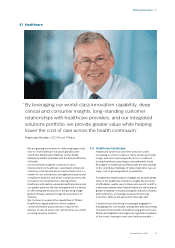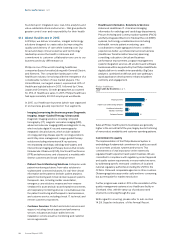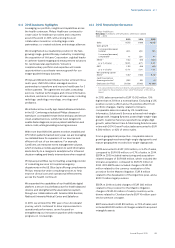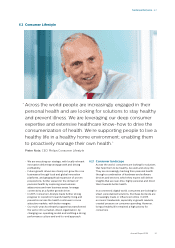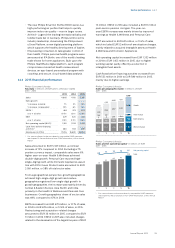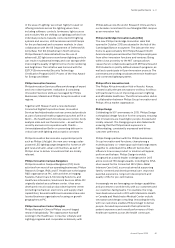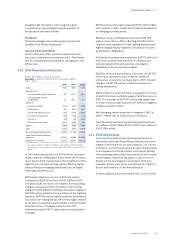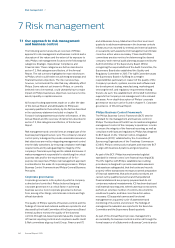Philips 2015 Annual Report Download - page 56
Download and view the complete annual report
Please find page 56 of the 2015 Philips annual report below. You can navigate through the pages in the report by either clicking on the pages listed below, or by using the keyword search tool below to find specific information within the annual report.
Sector performance 6.3.1
56 Annual Report 2015
ecient. At the same time, the lighting industry is
moving from conventional to LED lighting, which is
changing the way people use, experience and interact
with light. Digital technologies enable connectivity and
seamless integration in software architectures, systems
and services. Connected lighting allows light points to
be used as information pathways opening up new
functionalities and services based on the transmission
and analysis of data.
The lighting market is expected to grow by 2-4% per
annum between 2015 and 2019 (source: BCG). The majority
of this growth will be driven by LED-based solutions and
applications – heading towards a 60-65% share by 2018.
6.3.2 About Lighting in 2015
Philips Lighting is a global market leader with
recognized expertise in the development, manufacture
and application of innovative, energy-ecient lighting
products, systems and services that improve people’s
lives. We have pioneered many of the key
breakthroughs in lighting over the past 125 years, laying
the basis for our current strength and leading position
in the digital transformation.
We have a rm strategy which is based upon six
priorities:
• Optimize value from conventional products to
support growth
• Innovate in LED products commercially and
technologically to outgrow the market
• Lead the shift to systems, building the largest
connected installed base
• Capture adjacent value through new services
business models
• Be our customers’ best business partner locally,
leveraging our global scale
• Use our Accelerate! program to improve our
operational excellence
We aim to further invest to support our leadership in
LED and connected lighting systems and services while
at the same time capitalizing on our broad portfolio,
distribution and brand in conventional lighting by
exibly anticipating and managing the phase-out and
declining sales of conventional products.
We address people’s lighting needs across a full range
of market segments. Indoors, we oer lighting products,
systems and services for homes, shops, oces, schools,
hotels, factories and hospitals. Outdoors, we oer
products, systems and services for roads, streets, public
spaces, residential areas and sports arenas, as well as
solar-powered LED o-grid lighting. In addition, we
address the desire for light-inspired experiences
through architectural projects. Finally, we oer specic
applications of lighting in specialized areas, such as
entertainment, horticulture, and water purication.
In 2015, Philips Lighting spanned a full-service lighting
value chain – from lamps, luminaires, electronics and
controls to connected and application-specic systems
and services – through the following businesses:
• Light Sources & Electronics: LED, eco-halogen,
(compact) uorescent, high-intensity discharge and
incandescent light sources, plus electronic and
electromagnetic gear, modules and drivers
• Consumer Luminaires: functional, decorative,
lifestyle, scene-setting luminaires
• Professional Lighting Solutions: controls and
luminaires for city beautication, road lighting, sports
lighting, oce lighting, shop/hospitality lighting,
industry lighting
Philips Lighting
Total sales by business as a %
2015
56Light Sources & Electronics
7Consumer Luminaires
37Professional Lighting Solutions
In 2015, the Light Sources & Electronics business
conducted its sales and marketing activities through the
professional, OEM and consumer channels, the latter
also being used by our Consumer Luminaires business.
Professional Lighting Solutions was organized in a
project solutions business (project luminaires, systems
and services).
The conventional lamps industry has been highly
consolidated, with GE and Osram as main key
competitors. The LED lighting market, on the other
hand, is very dynamic. We face new competition from
Asia and new players from the semiconductor and
building management sectors. The luminaires industry
is fragmented, with our competition varying per region
and per market segment.
Under normal economic conditions, Lighting’s sales are
generally not materially aected by seasonality.
Philips Lighting has manufacturing facilities in some 25
countries in all major regions of the world, and sales
organizations in more than 60 countries. Commercial
activities in other countries are handled via distributors
working with our International Sales organization.
Lighting has approximately 34,000 employees
worldwide.
Commitment to quality
The implementation of the Philips Business System is
embedding a fundamental commitment to quality
across all our processes, products, systems and
services. Lighting is subject to signicant regulatory
requirements in the markets where it operates. These
include the European Union’s Waste from Electrical and
Electronic Equipment (WEEE), Restriction of



